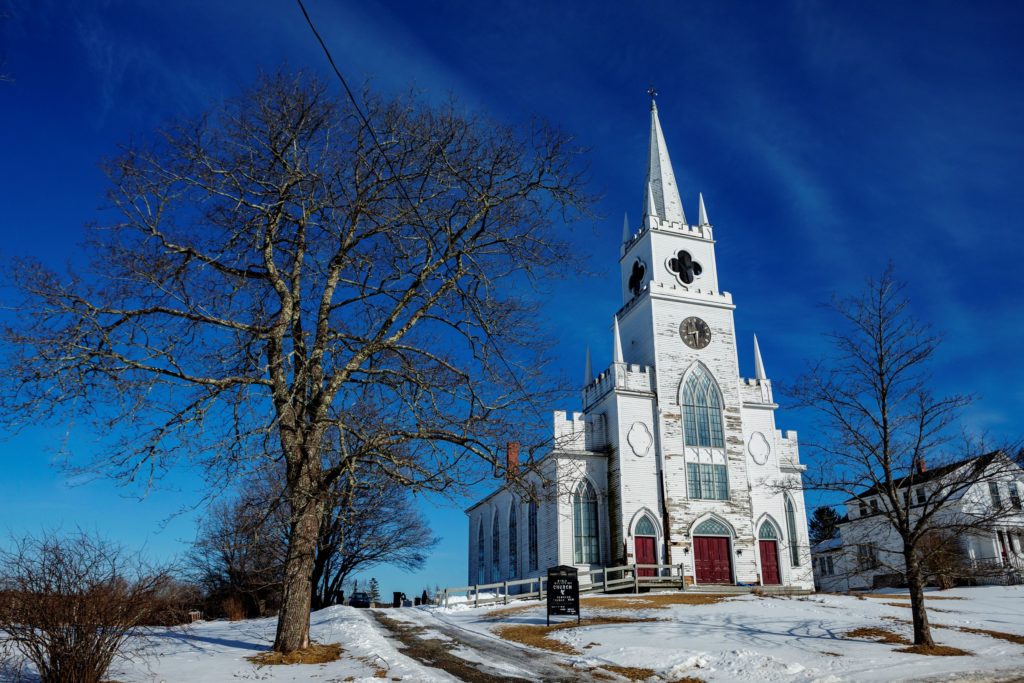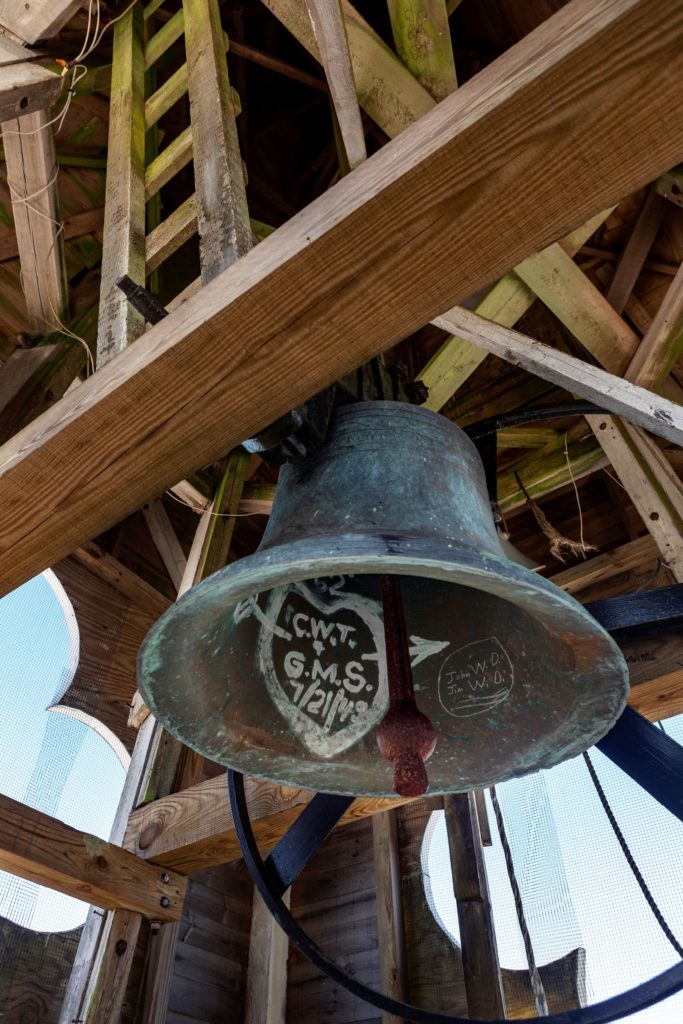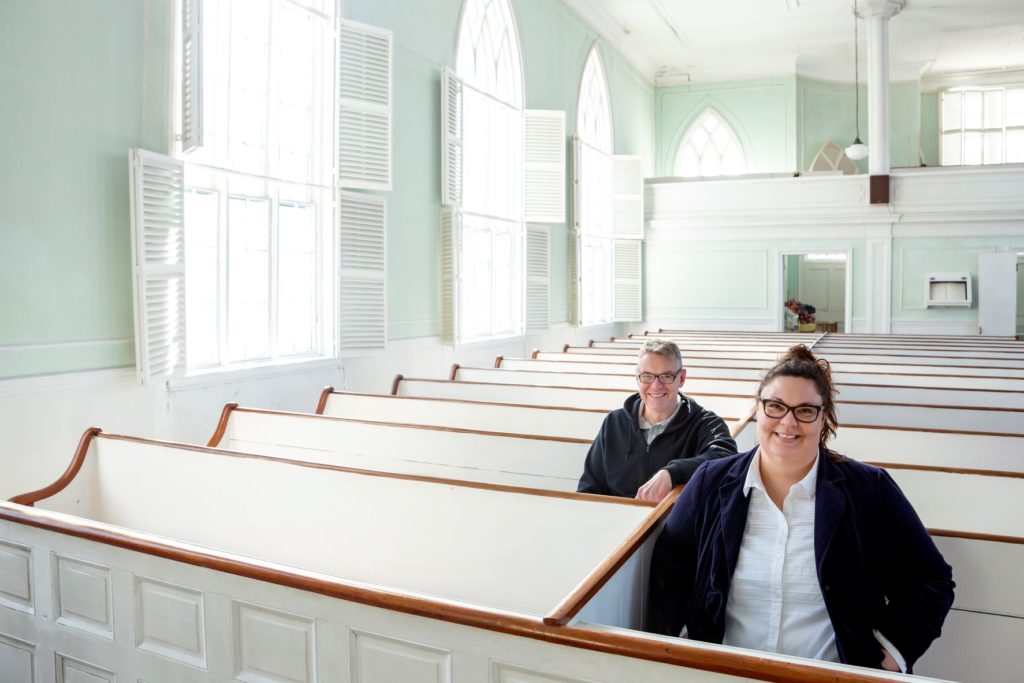
The First Congregational Church of East Machias was first led by Thomas Treadwell Stone, an outspoken abolitionist. A rotted timber post on the front left threatens its stability. Ashley L. Conti photos
In past months, as we kept our distance yet searched for ways to connect, one of Maine’s most endangered historic places provided an unlikely setting for gatherings – and inspiration for Washington County’s future.
People from around the state have rallied since last summer when it became clear the 185-year-old First Congregational Church of East Machias was dangerous – its stability undermined by a rotted timber post that supports the 115-foot steeple. Now, with a fast-paced outpouring of generosity from the community and Maine Community Foundation donors, restoration of the structure will begin this spring with hopes it can host a concert by fall. A production company plans to film the restoration for an hourlong special to be aired by a major television network.
The effort came to life with a visit last year from two representatives of the Maine Steeples Fund, which has provided financial assistance for the restoration of more than 75 Maine steeples since 2007. Church trustees began conversations in July about restoring the church for community use in a way that would honor its history. Throughout the pandemic, a small coalition of volunteers rallied to meet safely every week at the church, establishing nonprofit status to steward the structure through a 20-year lease. In just weeks after learning of the television proposal, Friends of the First Congregational Church of East Machias received donations of time and capital from more than 200 people. Donations now total $250,000, with another $100,000 pledged toward the project.
“The wonderful thing about this project is that the community has come together in a big way, driven by the desire to both honor their history and build a vision for the community gathering place of their future,” said Maggie Drummond-Bahl, director of philanthropy at MaineCF. “This is exactly the kind of approach that rural communities need to thrive.”

One restoration donor learned her grandfather left graffiti inside the church bell before he and her grandmother were married in 1949.
When Ann and David Ingram heard about the project, they couldn’t resist contributing to its success. The MaineCF donors both grew up in Congregational churches and are active in a church that is celebrating its 175th anniversary. “While we live in Massachusetts and have never been to East Machias, we have many important active connections to Maine including Washington County,” they noted. “We understand the importance of historical buildings to a town’s vibrancy and sense of place and celebrate the community’s vision to repurpose the church for a variety of future uses.”
The large white church that towers over East Machias was constructed in 1836, a Carpenter Gothic design that favored simplicity with just one cross and windows of leaded glass, not stained.
The congregation was led by Thomas Treadwell Stone, a Bowdoin College graduate and an outspoken abolitionist. It was there in 1837 that Stone delivered his powerful sermon, “The Martyr of Freedom,” which condemned the killing of his friend Elijah Parish Lovejoy over printing antislavery articles in Alton, Illinois. Today the church has only a handful of congregants who meet in the adjacent parsonage.

Erica Famous and Michael Henry are among volunteers leading the church preservation.
“It has been a venue for teachings on equality and freedom, and actually transcendentalism and cultural enlightenment since the beginning,” said volunteer Erica Famous, who grew up near the church and has close ties to a church trustee’s family.
This won’t be the first time the church was a community center. It was built on the site of the town’s meeting building and the deed specifies its continued use as a gathering place, said Michael Henry, another volunteer who lives across the street. Washington Academy held its graduation ceremonies at the church, and its 1872 George Stevens pipe organ once drew audiences for “entertainment.”
Henry sees the church as a centerpiece of preservation efforts in East Machias and hopes it will spur continued restoration of the town’s historic district. He envisions it as a classroom where students will learn the importance of history and the area’s rich past: “We certainly have a lot of it,” he added.
“Washington County is not the same county as it was when the church was born; our statistics speak for themselves,” said Famous. The county, once known for its mills and shipbuilding in East Machias, now ranks among Maine's lowest for median income.
“I think it’s just the most amazing opportunity that we have to share with the community, to honor their history – how important it is, how beautiful it is.”





